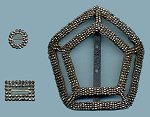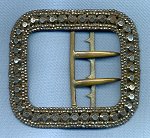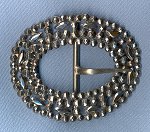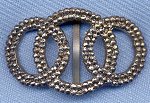|
Buckles - the trade at its height
Buckles, whether for shoes, belts or any other fastening purpose can
be made from a wide range of materials with an even wide range of
finishes. Wolverhampton was a steel working town, renowned for its
steel jewellery which was probably of many types. The trade
directories show great numbers of "buckle makers". These people
were not necessarily making only buckles and were not necessarily making
them only in steel - indeed, there are some people separately listed as
makers of japanned buckles. But the trade was dominated by the
making of steel buckles, especially shoe buckles.
 |
The Romans may have buckled their shoes and they were
certainly in use here in medieval times. But they were
usually sewn into a strap like the ones we still see today
on sandals and children's shoes. |
| Shoe buckles, such as those which Wolverhampton made,
were slipped on to a tongue of material from the shoe and
could be taken off, so that they could be put on another
shoe, or so that you could ring the changes with one pair of
shoes using different buckles. |
 |
 |
These buckles were in common and fashionable use for a
period of about 130 years, replacing, and then being
replaced by, what are called shoe ties or ribbons or strings
or, later, laces. One of the earliest recorded mentions of
shoe buckles is in Pepys' diary for the 22nd January 1660:
"This day I began to put buckles on my shoes". This seems to
date the start of the fashion. |
Holland and Hunt quote the "quaint" history of shoe fastening given
by "Hutton of Birmingham":
"This fashion (of piked toes), like every other, gave way to time
and, in its stead, the rose began to bud on the foot; which,
under the house of Tudor, opened in great perfection. No shoe was
fashionable without being fastened with a full blown
rose. Ribands of every colour, except white, the emblem of the
depressed house pf York, were had in esteem; but the red, like
the house of Lancaster, held the pre-eminence. Under the house
of Stuart, the rose withered, which gave rise to the shoe string,
The beaus of that age ornamented their lower tier with double laces
of silk, tagged with silver, and the extremities were beautified
with a small fringe of the same metal. The inferior classes
wore laces of plain silk, linen or even a thong of leather; which
last is yet to be met with in the humble plains of rural life.
... The revolution [sc. of 1688] was remarkable for the
introduction of William, of liberty, and the minute shoe buckle, not
differing much in size from the horse-bean. This offspring of
fancy, like the clouds, is ever changing - the fashion of to-day is
thrown into the casting pot of tomorrow. The buckle seems to
have undergone every figure, size and shape of geometrical
invention. It has passed through every form in the whole
zodiac of Euclid. The large square buckle, plated with silver,
was the ton of 1781. The ladies also adopted the
reigning taste: it was difficult to discover their beautiful
little feet, covered with an enormous shield of a buckle; and we
wondered to see the active motion under the massive load".
| The Euclidean pentagon is about 7 cms across at its
widest point. The round one is just under 1 cm across.
I have no idea how big a horse-bean is. |
 |
At first shoe buckles were attacked by critics as immodest ornaments
but the whims of fashion prevailed. They were made of many materials,
including gold and silver, and could be ornamented in any way the maker
could think of. But steel predominated and steel buckles were
predominantly made in Wolverhampton.
 |
This predominance of steel may not have been immediate.
Swan says that "from the late 1760s cut steel comes to the
fore, from the thriving industry of the Wolverhampton area".
Bilston was also a great centre of buckle making, and other
areas included Walsall as well as London and Birmingham.
Stebbing Shaw, in 1801, noted the following trades in
Darlaston:
gun-lock makers, nailers, fet makers, chape forgers, chape
makers, stirrup makers, buckle-ring forgers, and miners;
which shows that other places in the Black Country were in
on the trade too. |
| It has been suggested that Wolverhampton and Walsall
had a large trade in making horse harness and that these
towns therefore contained experienced buckle makers from
long ago; and that it was this skill which enabled them
to leap onto the shoe buckle bandwagon when it came
rolling by. |
 |
 |
But when Angerstein was in Wolverhampton in 1753 the
steel toy industry and the making of buckles was in full
swing. On arrival at his inn he noted that "scores of
smiths came in to offer their wares for sale [to the
merchants, or "factors"]. Included in these were
nails, tools, locks, hinges, key-rings, buckles, corkscrews,
watch chains, flat irons, crimping irons, sugar axes,
snuffers and other similar good in iron and steel".
|
| At another point, on a later visit to Wolverhampton,
Angerstein repeats the information: "It is particularly
renowned for all kinds of polished articles, such as
buckles, watch chains, candle snuffers, etc.".
As if the matter were of some special importance he devotes
a paragraph to explaining buckle manufacture. |
 |
 |
There are two parts to a shoe buckle. The operative part
is called the chape and includes the prongs which engage the
strap on the shoe. To the top of the chape is fixed the
ring, which is the part which is decorated. Together they
make up the buckle. Chape making, which was probably a mass
production affair, was a separate trade. |
| Mould says: "The buckle chape was almost the exclusive
trade of Bilston and the surrounding area. These craftsmen,
with huge supplies of English iron, would turn out thousands
a week". The workers described as buckle makers were the
people who designed and created the ring and attached them
to the chape. |
 |
 |
Angerstein does not mention chape making in Bilston but
he gives an account of Wolverhampton buckle making.
Despite being accompanied by drawings this explanation is
not as clear as might be. It is, however, clear that
different operations were carried out in different shops,
the chape (or "hook and spike" as Angerstien's translators
have it) in one shop and the ring in another.
|
The chape, he says, is made out of sheet metal, which is
cut to the shape required and its mirror image, and the whole is then
folded upon itself, heated and soldered and stamped, to produce a blank.
The centre is then removed by "stamping" (which appears from the
sketches to be chiselling out rather than stamping). It is then
filed, presumably to remove roughnesses and to provide a proper finish.
The ring is made (in another shop) by bending metal into a circle and
then welding the ends together and then "made square on the point of an
anvil". He says nothing about any further decoration of the
ring.
|

